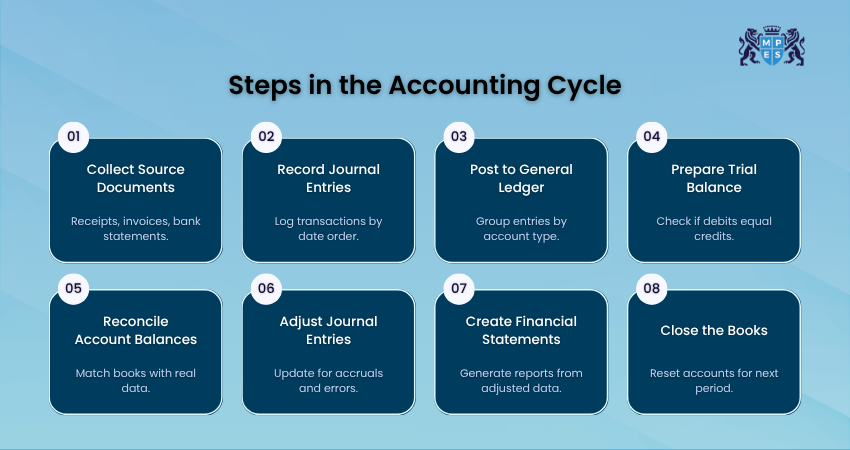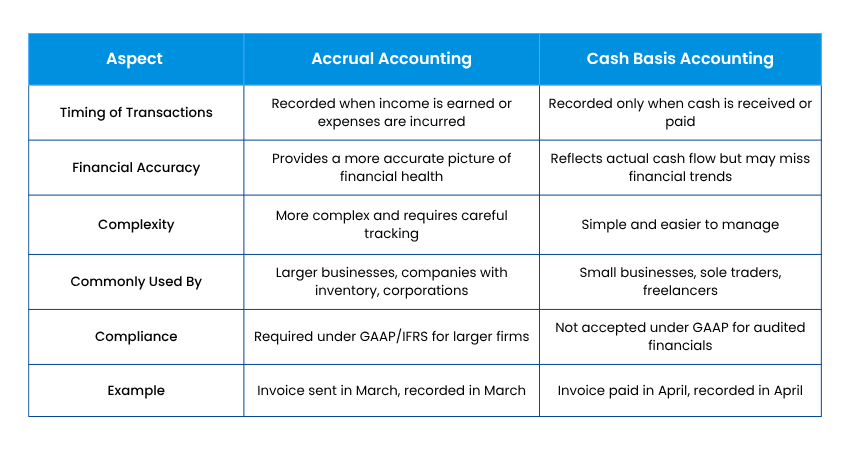Table Of Contents


How do companies take a whirlwind of day-to-day transactions and turn them into crystal-clear financial reports? The key lies in the Accounting Cycle, a step-by-step process that takes raw financial data and turns it into meaningful insights. From sales and expenses to profits and losses, this cycle sees to it that every transaction is recorded with precision and purpose.
The Accounting Cycle functions as a roadmap of finances, leading companies from basic bookkeeping to informed strategic decision-making. The process lays one step upon another, and this develops a sound system for monitoring financial transactions and generating accurate reports that indicate a company's genuine financial condition.
Table of Contents
What is the Accounting Cycle?
Why Is the Accounting Cycle Important?
How Does the Accounting Cycle Work?
Steps in the Accounting Cycle
What Are Benefits of the Accounting Cycle?
Comparing Accrual and Cash Basis Accounting
Conclusion
What is the Accounting Cycle?
The Accounting Cycle is a complete, step-by-step process that firms utilize to detect, analyze, record and report financial transactions throughout an agreed period of accounting. It starts with a transaction and concludes with the preparation of correct financial statements. This process ensures that all financial activities are methodically recorded and assessed which ensures accuracy, transparency and accounting standards compliance.
The cycle is also an important aid in ensuring consistency from one period to another. It is necessary for comparison of performance and making sound decisions. By adopting this systematic method, companies can keep orderly records, identify mistakes early enough, and give stakeholders solid financial information. Let us clarify this phenomenon with an example:
Imagine a retail business that sells clothing. Here’s how the Accounting Cycle would work over one month:
Transaction Occurs: The business sells a jacket for £80.
Journal Entry: This sale is recorded in the journal as revenue.
Posting to Ledger: The £80 is posted to the sales account in the general ledger.
Unadjusted Trial Balance: At month-end, all accounts are checked for accuracy.
Adjusting Entries: The business notes unpaid utility bills and records them.
Adjusted Trial Balance: The updated figures are reviewed again.
Financial Statements: The income statement shows total sales, and the balance sheet reflects current assets and liabilities.
Closing the Books: Temporary accounts like revenue are closed, readying the books for the next cycle.
Why Is the Accounting Cycle Important?
The Accounting Cycle isn’t just a routine; it’s the backbone of good financial management. Here’s why it matters so much for any business:
Keeps Records Accurate: It ensures every transaction is properly recorded, helping to avoid costly mistakes and confusion down the line.
Creates Consistency: By following the same steps each time, businesses can compare their financial performance across months or years with confidence.
Helps Stay Compliant: It supports meeting legal and tax requirements by making sure financial reports are complete and accurate.
Improves Decision-Making: With clear financial data, owners and managers can make better, well-informed decisions for the future.
Builds Trust: Accurate, timely reports give investors, lenders, and stakeholders confidence in how the business is being run.
Makes Audits Easier: Having everything in order means audits are less stressful and more efficient.
Spots Issues Early: It helps catch errors or unusual activity before they turn into bigger problems.
How Does the Accounting Cycle Work?
The Accounting Cycle works like a roadmap that helps businesses keep their finances in check, step by step. It all starts when a transaction happens, like a sale, a payment, or a purchase. From there, that transaction is recorded, sorted, and reviewed until it’s part of a complete financial report.
Each stage in the cycle has a purpose. First, the transaction is written down in a journal. Then it’s posted to the ledger, where everything is grouped into categories like sales, expenses, or assets. After that, businesses prepare a trial balance to make sure everything adds up. If any adjustments are needed, like unpaid bills or earned revenue, they’re made before creating the final financial statements.
Once everything is accurate and complete, the books are closed for that period. Then, the cycle starts again. It’s a repeatable process that helps businesses stay organised, avoid mistakes, and make smart financial decisions.
Strengthen your financial skills with CIMA’s BA3 Fundamentals of Financial Accounting course.
Steps in the Accounting Cycle
The Accounting Cycle follows a clear 8-step process to help businesses stay on top of their finances. Here’s a breakdown of each step, just like the one shown in the visual:

Collect and Organise Source Documents
Every transaction begins with a document, like a receipt, invoice, or bank statement—that serves as proof and reference for accounting.
Record Transactions in the Journal
Transactions are then recorded in a journal in chronological order using the double-entry method to keep accounts balanced.
Post Entries to the General Ledger
The journal entries are transferred to the general ledger, where all financial data is grouped by account for easy tracking.
Prepare the Trial Balance
A trial balance is created to ensure total debits equal total credits. It’s an important checkpoint before moving forward.
Reconcile and Review Account Balances
Account balances are reviewed and compared with real-world data like bank statements to spot any discrepancies or errors.
Post Adjusting Journal Entries
Adjustments are made for items like accruals, deferrals, or depreciation to reflect accurate financial activity.
Generate Final Financial Statements
Financial statements, such as the income statement, balance sheet, and cash flow statement are prepared using adjusted data.
Close the Books for the Period
At the end of the period, temporary accounts (like income and expenses) are closed out, and the cycle resets for the next accounting period.
What Are Benefits of the Accounting Cycle?
The Accounting Cycle brings structure, clarity, and reliability to financial management. Here are the key benefits it offers to businesses:
Organises Financial Records Efficiently: Helps businesses keep all financial records organised and easy to track.
Minimises Errors with a Structured Process: Reduces the chances of errors by following a step-by-step process.
Enables Better Financial Decision-making: Provides accurate data that supports better financial decisions.
Simplifies and Streamlines Tax Preparation: Makes tax preparation simpler and more efficient.
Builds Confidence Among Stakeholders: Builds trust with investors, lenders, and other stakeholders.
Ensures Complete and Accurate Transaction: It ensures that all transactions are recorded and accounted for.
Facilitates Smooth and Hassle-free Audits: It prepares the business for smooth and hassle-free audits.
Provides Insight into Financial Performance: Offers a clear picture of financial performance over time.
Comparing Accrual and Cash Basis Accounting
Here following are the key points of comparison between Accrual and Cash Basis Accounting:

Conclusion
The Accounting Cycle may seem like a routine, but it’s what keeps a business’s finances running smoothly behind the scenes. It helps turn everyday transactions into clear, meaningful reports that actually tell you how your business is doing. When done right, it brings clarity, saves time, and builds trust. Whether you're just starting out or managing a growing company, understanding the Accounting Cycle is a simple way to stay in control and make better financial choices.
Sharpen your financial reporting skills, enrol in ACA Professional Level – Financial Accounting and Reporting: UK GAAP course now.
 Have Any Question?
Have Any Question?
 +44 7452 122728
+44 7452 122728






 Back
Back








 44 7452 122728
44 7452 122728





